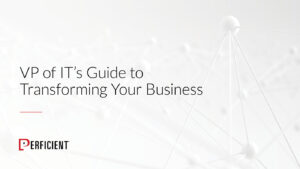IT leaders are under constant pressure to improve operations and stay on top of trends in the rapidly evolving world of modern business. In our guide, the ‘VP of IT’s Guide to Transforming Your Business’ we discussed the benefits of adopting a product-driven organization over a project-driven one. In our first blog in this series, ‘Product-Driven vs Project-Driven: What’s the Difference?’ we discussed the differences between these two approaches, explored the benefits of adopting a product-driven approach over a project-driven one, and why it’s essential to prioritize the creation and ongoing improvement of specific products.
Today, we will dive deeper into the topic and discuss key success factors that organizations must adopt when transitioning from a project-driven approach to a product-driven approach and provide practical tips on how to overcome challenges.
Establish a Product Vision and Roadmap
Instead of creating solutions just to keep busy, it’s essential to establish what problems the organization is trying to solve and what goals they’re trying to achieve. This helps everyone to be aligned with the same objectives and work together to achieve them.
Establishing key performance indicators (KPIs) is one way to ensure that the organization is on the right track to achieving its goals. For example, the organization may want to deliver a new set of digital tools to customers for self-service to reduce call volume. The goal may be to have customers’ questions answered and their problems solved without the need for a call center agent, thereby reducing calls by 10%. This will not only help the organization achieve its goal of reducing call volume but will also lead to a better customer experience.
Other KPIs may include:
- Reduce call handle time
- Increase customer retention
- Increase ratings (whether it’s App Store or CMS Star rating, etc.)
- Increase market share
- Speed to market
- Feature adoption
- Product quality
It’s essential to keep the organization’s goals and KPIs in mind when developing the product vision and roadmap. The product vision should align with the organization’s mission and goals, and the roadmap should outline how the product will evolve over time to achieve those goals.
Remain Customer-Focused
In order to build successful products, it is crucial to focus on the customers and how they are interacting with your products. One of the key ways to do this is to gather feedback from your customers and use it to drive your product backlog for your team. Having a pulse on your customers’ needs and wants is essential to providing them with the best possible experience.
When gathering feedback, it is important to ask questions like:
- How do you rate the product?
- What do you like/dislike about the product?
- How easy or difficult is it to use the product?
- How frequently do you use the product?
- What features would you like to see added to the product?
- How does our product compare to competitors?
There are several places to gather feedback from customers, including ratings for a mobile app, ratings on sites like Trip Advisor or Yelp, and direct surveys that ask customers how you did today. In addition, focused outreach for more in-depth surveys can also be helpful. When analyzing this feedback, it is important to look at analytics on how your products are being used. With defined KPIs in place, you can remain metrics-driven to measure success when implementing your changes.
Embrace Agile Methodology
Agile methodology is a crucial factor to consider when transitioning from a project-driven approach to a product-driven approach. Agile is a development approach that emphasizes flexibility, collaboration, and customer satisfaction. It is a set of values and principles that prioritize individuals and interactions, working software, customer collaboration, and responding to change over rigid processes and documentation.
Continuous Delivery is an essential aspect of an Agile methodology. This means that the organization can adapt its work based on customer feedback and business needs, prioritizing its work to continue evolving and improving while delivering frequently. By continuously improving and adapting to customer feedback, organizations can build stickiness, loyalty, and trust with their customers.
For example, if a customer visits an app store and sees that an app hasn’t been updated in two years, they may hesitate to download it as it may not be perceived as valuable and won’t be able to use the latest features of modern mobile operating systems. Continuous delivery ensures that an organization’s products remain relevant and up to date, increasing customer trust and loyalty.
Reframe your Funding Model
When it comes to funding a product-driven approach for product development, it’s important to have a model that focuses on funding products rather than individual projects. This means assigning a team to work on the product and giving them the necessary resources and funding to see it through from start to finish. If an organization relies on a waterfall-like funding model with predetermined gates and milestones, they risk hindering the progress and agility of the product team. For example, giving only a small percentage of funding for the design phase will limit the ability of the team to pivot and make changes based on customer feedback.
By funding products instead of projects, teams can remain focused on the bigger picture and the overall product vision. This approach helps align team members with the goals and purpose of the product they’re building, allowing them to become more invested in the process. As a result, they’re more likely to be innovative and creative, looking for ways to improve the product and make it the best it can be.
Empower Product Ownership
To successfully implement a product-driven approach to product development, it’s important to establish clear ownership of the product. This means empowering product managers and owners to make decisions and drive the vision of the product. The product backlog should be constructed by the product owner in collaboration with stakeholders and the implementation team so that the team can build the product according to the desired outcomes.
If a product manager needs to go in front of a steering committee to get approval for every decision, it’s going to slow down the development process significantly. It’s much more efficient if someone is empowered to drive the product with the support of leadership so that product managers and owners can be trusted to make the right decisions for the product. Ultimately, a product owner who is able to effectively communicate the product vision and align the team with that vision will help ensure its success.
Next Steps
By establishing a clear product vision and roadmap, remaining customer-focused, embracing Agile methodology, adopting a funding model that supports product development, and empowering product owners to drive the vision of the product, you will have the essential components you need to successfully implement a product-driven approach. By implementing these practices, organizations can achieve faster time-to-market, increase customer satisfaction, and drive business outcomes through technology.
If you’re interested in learning more about driving innovation through technology, we suggest checking out the “VP of IT’s Guide to Transforming Your Business.” This guide offers insights and answers to the top questions IT leaders are asking about cloud strategy, data, DevOps, and product development. It provides a comprehensive look at the latest trends and best practices for driving business outcomes through technology.


This is a very informative and insightful article on the differences and benefits of a product-driven approach over a project-driven one. I agree that a product-driven approach is more aligned with the business goals and customer needs, and that it fosters a culture of innovation and collaboration. I especially liked the practical tips on how to transition from a project-driven approach to a product-driven one, such as establishing a product vision and roadmap, remaining customer-focused, funding products rather than projects, and empowering product teams. Thank you for sharing your expertise and experience on this topic.
Very nice Article. Lots of information. Thank you very much.
I would like to introduce you to a new website Bazaarroom.com
Bazaar Room is an online platform that facilitates connection between buyers and sellers of skills, services and products.
Please visit our website and read how its works .
Work with people for people.